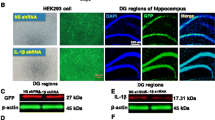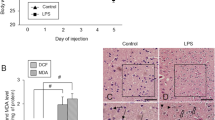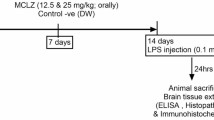Abstract
Lipopolysaccharide (LPS) from gram negative bacteria plays an important role in the pathophysiology of neurodegenerative diseases. Many evidences showed that LPS-induced neuroinflammation is related to upregulation of NF-kappaB. Here, we report that long-term treatment of lower dosage LPS mainly causes upregulation of Id2 protein. As an inhibitor of cell differentiation, Id2 plays an import role in adult olfactory neurogenesis. However, Id2 protein in brain acts as two edges in a sword, persist over-expression of Id2 in brain can induce neurodamages and may be related to neurodegeneration.




Similar content being viewed by others
References
Haddad JJ (2009) Endotoxin-mediated regulation of nuclear factor-kappaB nuclear translocation and activation in the hippocampus of the central nervous system: modulation by intracerebroventricular treatment with thymulin and the immunomodulatory role of the IkappaB-alpha/pIkappaB-alpha pathway. Neuroscience 164:1509–1520
Hang CH, Shi JX, Tian J et al (2004) Effect of systemic LPS injection on cortical NF-kappaB activity and inflammatory response following traumatic brain injury in rats. Brain Res 1026:23–32
Zhang F, Qian L, Flood PM et al (2010) Inhibition of IkappaB kinase-beta protects dopamine neurons against lipopolysaccharide-induced neurotoxicity. J Pharmacol Exp Ther 333:822–833
Qin L, Wu X, Block ML et al (2007) Systemic LPS causes chronic neuroinflammation and progressive neurodegeneration. Glia 55:453–462
Maes M, Kubera M, Leunis JC (2008) The gut-brain barrier in major depression: intestinal mucosal dysfunction with an increased translocation of LPS from gram negative enterobacteria (leaky gut) plays a role in the inflammatory pathophysiology of depression. Neuro Endocrinol Lett 29:117–124
Tzeng SF, Vellis J (1998) Id1, Id2, and Id3 gene expression in neural cells during development. Glia 24:372–381
Chen XS, Zhou DS, Yao ZX (2007) The inhibitor of DNA binding 2 is mainly expressed in oligodendrocyte lineage cells in adult rat brain. Neurosci Lett 428:93–98
Pang Y, Campbell L, Zheng B et al (2010) Lipopolysaccharide-activated microglia induce death of oligodendrocyte progenitor cells and impede their development. Neuroscience 166:464–475
Lofstedt T, Jogi A, Sigvardsson M et al (2004) Induction of ID2 expression by hypoxia-inducible factor-1: a role in dedifferentiation of hypoxic neuroblastoma cells. J Biol Chem 279:39223–39231
Vandeputte DA, Troost D, Leenstra S et al (2002) Expression and distribution of id helix-loop-helix proteins in human astrocytic tumors. Glia 38:329–338
Gleichmann M, Buchheim G, El-Bizri H et al (2002) Identification of inhibitor-of-differentiation 2 (Id2) as a modulator of neuronal apoptosis. J Neurochem 80:755–762
Florio M, Hernandez MC, Yang H et al (1998) Id2 promotes apoptosis by a novel mechanism independent of dimerization to basic helix-loop-helix factors. Mol Cell Biol 18:5435–5444
Kitajima K, Takahashi R, Yokota Y (2006) Localization of Id2 mRNA in the adult mouse brain. Brain Res 1073–1074:93–102
Havrda MC, Harris BT, Mantani A et al (2008) Id2 is required for specification of dopaminergic neurons during adult olfactory neurogenesis. J Neurosci 28:14074–14086
Bai G, Sheng N, Xie Z et al (2007) Id sustains Hes1 expression to inhibit precocious neurogenesis by releasing negative autoregulation of Hes1. Dev Cell 13:283–297
Jung S, Park RH, Kim S, Jeon YJ et al (2010) Id proteins facilitate self-renewal and proliferation of neural stem cells. Stem Cells Dev 19:831–841
Lasorella A, Rothschild G, Yokota Y et al (2005) Id2 mediates tumor initiation, proliferation, and angiogenesis in Rb mutant mice. Mol Cell Biol 25:3563–3574
Acknowledgments
This work was supported by National Natural Science Foundation of China (30772196).
Author information
Authors and Affiliations
Corresponding author
Rights and permissions
About this article
Cite this article
Wang, LY., Niu, Zz., Hu, Bx. et al. Long-term intraperitoneal injection of lipopolysaccharide induces high expression of Id2 in the brain of mice. Mol Biol Rep 38, 4193–4196 (2011). https://doi.org/10.1007/s11033-010-0540-1
Received:
Accepted:
Published:
Issue Date:
DOI: https://doi.org/10.1007/s11033-010-0540-1




